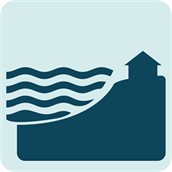Coastal and fluvial flood insurance
The different types of floods also have different types of coverage from risk transfer instruments. In the Netherlands, we have two types of risk transfers: private flood insurance and governmental compensation.
Private Insurance
In 1953 a major flood occurred in the Dutch province of Zeeland. Afterwards, many Dutch insurers withdrew their coverage. More recently, damage from floods is increasingly insurable in the Netherlands. However, there are some differences in the insurability of damage from different types of floods. The picture below shows the different types of floods according to the European Floods Directive (EFR): A, B, C and D. Damage caused by floods from the regional water system (types C and D) are most often covered by private flood insurance for homeowners and businesses. For homeowners, this is often part of contents and/or building insurance. Motor vehicles can also be insured against flooding.
In the Netherlands, it is very challenging to offer flood insurance on a large scale that covers flooding from the sea, large inland waters, or major rivers (type B floods). Some insurers have attempted this, but research by the Dutch Association of Insurers (PDF) shows it has never been successful in covering more than 1 percent of households against this risk. In addition, the Disasters and Serious Accidents (Compensation) Act (WTS) provides public compensation for these types of floods, among other uninsurable hazards in the Netherlands.

Compensation from the Dutch Government
In the Netherlands, the WTS is invoked when the central government declares a flood a national disaster. Introduced in 1998, the WTS enables the government to reimburse victims for a significant portion of the damage incurred. Since its inception, the WTS has been activated five times in response to localised flooding following extreme rainfall and breaches of embankments.
The law primarily stipulates that compensation is determined by ministerial regulation. This means that compensation depends on political decisions, and therefore citizens and businesses are not guaranteed certainty. In addition, the WTS does not provide a full coverage of damages. The focus of the WTS is flooding from overtopping or a breach of the primary flood defences (type B). The Dutch Association of Insurers has included an overview of current standard coverages for flooding.
Uncovered flood damage
Flooding in unprotected areas or unembanked areas (type A) are generally not covered by the WTS. Private insurance for homeowners also excludes type A floods from their coverage. Businesses have options to get custom private insurance packages that includes coverage from type A floods, but this is often only for larger businesses and industries. The Dutch Association of Insurers is currently investigating (PDF) whether properties water safe unembanked areas, like former harbours built on higher elevation, could be insurable.

